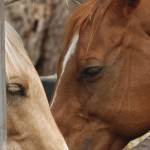Nutritional Factors in Equine Colic

Many abdominal disturbances that result in colic can be traced back to changes in gut motility or bacterial flora. The horse was designed to be a grazer, ingesting small quantities of forage all of the time. In an attempt to feed the highest quality rations for maximum performance, horsemen should not overlook the potential complications caused by different feeding regimes.
Colic refers to any abdominal pain in a horse. The causes are numerous and many are unidentified, but in general they are related to the anatomy of the horse’s gastrointestinal (GI) tract and the balance of bacterial flora in the gut. An abrupt change in the bacterial flora can result from feeding too much grain, improper ratios of forage and grain, or moldy forage or grain.
To better appreciate the mechanism of colic, keep in mind the anatomy of the horse’s GI tract. The horse is a hindgut fermenter, more like a rabbit than a dog. The path of ingesta through the horse’s GI tract once it leaves the mouth includes the esophagus, stomach, small intestine, cecum, large colon, small colon, and rectum. The cecum and large colon are segments of the tract that allow for fermentation and absorption of nutrients after partial digestion in the stomach and small intestine. These large segments are prone to malfunctions in position and motility, both of which can be nutritionally related.
The first category, an improper position, can sometimes be attributed to diet. A change in diet that increases gas production may cause part of the intestinal tract to become buoyant as well as create abnormal motility, which in turn leads to a change in position. Displacement or torsion is most common in the large colon. The large colon forms two horseshoe-shaped loops, one on top of the other, on the floor of the abdomen. These loops have little tissue attachment and can therefore be almost free-floating. Gas buildup is one potential cause of large colon displacements, torsions, and nephrosplenic entrapments. Some simple displacements can be corrected without surgery, whereas other lesions, including torsions, must be corrected surgically.
The second category, malfunctions of motility, can be due to the feed consistency and content. Impactions or increased transit time can result from lack of moisture or too much coarse material. Impactions generally occur far more often in confined horses versus those that are turned out. Common sites of impaction include the pelvic flexure of the large colon, the transverse colon, and the cecum. All three sites are areas of abrupt change in the diameter of the colon.
Feed management can play a role in minimizing these causes of colic. Make changes to the horse’s diet gradually over a period of a week or more. Be sure the horse has a constant supply of clean water that is not too cold. Turn horses out as much as possible, and avoid feeding hay that contains a large proportion of tough, stemmy forage.








